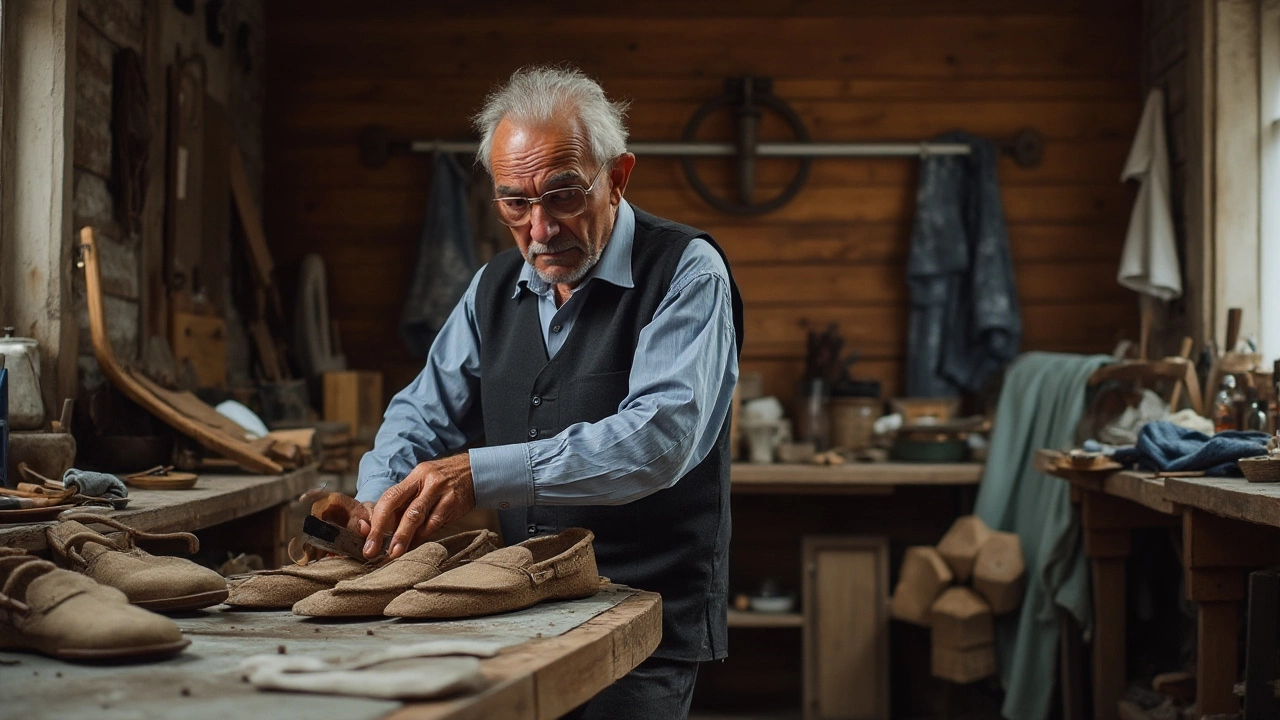Choosing the Perfect Slipper Size: Bigger or Smaller?

Shopping for slippers might seem simple, but finding the right fit can sometimes be a bit tricky. Do you buy them a tad bigger for a relaxed fit or opt for a snug size to keep the chill away? Knowing just the right size can mean the difference between cozy evenings and uncomfortable nights. Dive into this well-stitched conversation as we unravel the age-old question of slipper sizing and bring you practical advice to keep your feet happy.
Sizing Basics
When it comes to buying slippers, understanding size basics is essential to ensuring both comfort and longevity. Slipper sizing can be a bit more forgiving than other types of footwear due to their often cozy and flexible design, but this does not mean that any size will do. Most slippers are generally true to size but some brands may have their own unique sizing information, which can be a little confusing for shoppers. It's important to begin by knowing your exact foot size, which can be measured at home using a simple tape measure. First, trace your foot on a piece of paper and measure the longest point from heel to toe. This will give you the length, which you can compare to a standard foot size chart. Yet, this is merely the first step in unraveling the slipper sizing mystery.
Another aspect that's worth considering is variability between sizing for men and women. Typically, slipper sizes correspond with standard shoe sizes, but sometimes men's and women's slippers may be marked differently. For example, a women's size eight slipper might not fit the same as a men's size eight due to the shape and width differences of the foot they are designed for. Some brands offer unisex sizing to simplify things; however, checking the brand-specific sizes remains critical. Alongside this gender distinction, there are cultural variations too – European sizes are quite different from US sizes, which can perplex the unwary shopper.
In addition to the direct measurements and gender differences, there's also the concept of half-sizes or lack thereof in slippers. Many slipper styles do not offer half-sizes at all, placing shoppers in a conundrum of choosing between a smaller or larger size. Opting for a size up might mean more comfort in terms of looseness, but it could compromise warmth and fit, particularly if the slippers start to stretch with use. A size down can embrace the feet snugly but may present tightness, primarily in new slippers, before they naturally adjust and loosen with wear. To make an informed decision, considering the slipper's primary use, whether for lounging indoors or stepping outside, could also help in guiding your choice.
“Feet differ as much as faces. Some are long and narrow, others short and thick with plump insteps and long toes,” writes style icon and shoe expert Diana Vreeland. Her observation beautifully captures the diversity of our feet and serves as a gentle reminder that one size doesn't fit all, especially in the world of slippers.
Comfortable slippers are more than just size; they are about individual preference and knowing what gives your feet the best cozy embrace. One person's preference for a slipper that they can slip on easily might mean choosing a size larger, while someone who prefers more grip and warmth might go one size smaller. Consideration of personal needs, style of the slipper, and the occasion are as important as the size label itself.

Material Considerations
When deciding whether to select slippers a size bigger or smaller, it's essential to consider the material composition of the slippers. Materials play a pivotal role in determining not only comfort but how the slippers will wear over time. For instance, slippers made from natural fibers like wool or cotton tend to have a bit more give. They can stretch slightly to accommodate the foot and may become roomier with wear. In contrast, synthetic materials, while often durable, might not offer the same flexibility, urging some to consider a larger size to ensure a relaxed fit from the start.
Materials such as fleece or faux fur offer warmth and a plush feel but can sometimes compress under pressure. This compression might lead to a fit that feels snugger after a few wears, which means buying them slightly bigger could provide lasting comfort. Leather slippers, cherished for their durability and classic style, often need breaking in. This process can slightly alter their fit as the material molds to your foot's shape over time, making the initial snugness eventually adjust to a more custom fit.
Adding to this consideration are memory foam footbeds, increasingly popular for their cushioning effect. These footbeds adapt to your foot's contours, but when paired with tightly woven fabric uppers, getting a size too small can lead to boundaries that don't yield easily. In such cases, opting for a larger size might be wiser to accommodate the footbed’s adaptability.
According to Emma Thomas, a footwear specialist, 'The key lies in understanding how each material interacts with your foot over time.'This means taking into account not only how the material feels initially, but how it evolves.
One surprising factor that can affect slipper material performance is humidity. Under moist conditions, materials like suede may become more malleable, causing changes in fit - something to consider if sizing up or down. While materials like rubber provide excellent choices for moisture-wicking properties and durability, they offer little stretch. Thus, for those with broader feet, considering a larger size might strike a balance between comfort and functionality.
It's evident that the intrinsic properties of slipper materials can significantly impact the decision to size up or down. By focusing on the interaction between these materials and your foot's natural tendencies, a well-informed choice can be made, leading to both comfort and satisfaction. While material is just one piece of the puzzle, it’s a critical one, often defining how often and how long those slippers will cradle your feet with comfort.

Foot Shape and Size
When it comes to choosing the right pair of slippers, the foot shape plays a significant role in deciding whether to size up or down. Not all feet are created equal; some are narrow and others are wide. Some people have high arches, while others have flat feet that affect how slippers fit and feel. Understanding your foot's unique shape can help you determine if a size adjustment is necessary. Have you ever slipped on a pair of slippers only to find them uncomfortably tight around the sides? This could be due to a wider foot needing more room. In such cases, opting for a size larger might offer more freedom without sacrificing comfort.
To make matters a bit more interesting, the length of your toes and the overall length of your feet must also be considered. In fact, a recent study found that around 60% of people have one foot larger than the other, which can complicate the sizing process. A helpful tip is to measure both feet and use the larger measurement as your guideline when selecting comfortable slippers. This ensures that even the larger foot enjoys a snug fit. Moreover, age and other physical factors can cause foot changes over time, so individuals should periodically re-check their size to ensure the best fit.
According to Dr. Emily Splichal, a podiatrist, 'People underestimate the importance of foot shape more than size. The width and arch height can significantly dictate the need to adjust slipper sizes.'
Beyond natural variations, conditions such as bunions can make finding the right slipper size even more challenging. Individuals dealing with bunions or other deformities may find standard sizes don't account for additional space needed around the affected areas. It's crucial to be mindful of these aspects and to prioritize comfort over simply sticking to a standard size chart. Different brands might have slight variations in their sizing, so trying on a few different pairs or reading reviews could offer insight into how a particular slipper model might accommodate various foot shapes.
It's also worth noting that the perfect fit slippers not only feel good but also prevent issues like blisters and calluses, thereby contributing to overall foot health. Considering all these factors, be sure you know your foot shape before deciding on sizing up or down in your next slipper purchase. Armed with this knowledge, you are more equipped to make a choice that caters specifically to your foot shape and size.

Practical Tips
Choosing the right size for slippers can feel like navigating a complex puzzle where comfort, durability, and style intersect. First and foremost, consider the primary material of your slipper. Comfortable slippers often have some stretch or give, especially if made from materials like wool or certain leathers. These materials expand slightly over time, which means opting for a snug fit initially might be wise. On the other hand, rigid materials such as synthetic fabrics might not offer the same stretch, suggesting a size larger could be appropriate for prolonged comfort.
Understanding your foot's nuances is equally critical. Everyone's foot shape is unique, influenced by genetics and lifestyle choices. People with wider feet might find going a size up more comfortable, especially in slippers with narrower designs. In contrast, those with narrow feet may find their ideal fit lies half a size down to avoid slipping. Interestingly, a study highlighted that almost 60% of adults wear shoes that are not the right size, sparking discomfort and potential health issues. Thus, trying on different sizes and styles is key to finding the perfect slipper size.
Next, consider how you intend to use your slippers. For primarily indoor use, such a snug fit might provide the necessary support to prevent falls on slippery floors. However, if you anticipate some level of outdoor use, like stepping out to the mailbox, a slightly larger size offers the buffer needed for socks, enhancing warmth in nippy weather. According to a survey by the Footwear Association, layering with socks during winter months is a widespread practice, with 70% of respondents admitting they prefer larger slippers for this reason.
Test Your Fit
One hands-on method to ensure you have the right size is the thickness test. Try your slippers on while wearing socks of varying thicknesses. The ideal perfect fit slippers should feel cozy but not restrictive with medium-thickness socks, a common thickness worn in seasonal houses. If possible, measure the insole length and compare it with your foot length. Many online retailers offer size guides, though a visit to a physical store provides a tangible feel that numbers can't.Maintaining and adjusting your slipper's fit over time is also an essential consideration. Many slipper buying tips emphasize the importance of maintaining their structure. Techniques such as using wooden shoe stretchers can help widen your slippers slightly without damaging them. Periodic cleaning also ensures materials like suede or shearling maintain their original fit and comfort. Remember, like any footwear, proper care can extend the life and comfort of your slippers, saving you both money and future headaches.